Once the light-bulb-network (discussed in week 9 of this course) had firmly taken hold, lighting the urban landscape at night became a possibility. As Brown Professor Dietrich Neumann writes in his book, Architecture of the Night:
- "Electric light was considered a potential new "building material" that could bring about conceptual changes as profound as those caused by the arrival of steel and plate glass." (1)
An early example of this urban illumination was the revolutionary night-lighting of the Chicago World's Fair in 1893. The neoclassical facades of the exhibition building were lit with brilliant electric light, significantly extending the hours in which a city could remain teeming with light. Chicago remained a world leader in illuminated architecture, with one important early example being the Wrigley Building. The Wrigley Building, constructed 1920-21, was and is still lit by white floodlights from near the street level. The building's terra-cotta clad facade gets lighter in color near the top of the building, and the floodlighting intensifies there as well; the effect is a stark emphasis on the height of the skyscraper (2). The lights make the facade seem bright, reflective and clean - appropriate for a building funded by a man who made his fortune off of chewing gum!
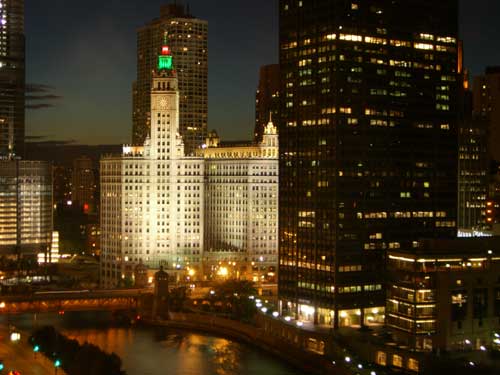
Right across the street is the Chicago Tribune Building. This plans for this building were chosen from a famous competition held in 1922. Competition entries included the following:
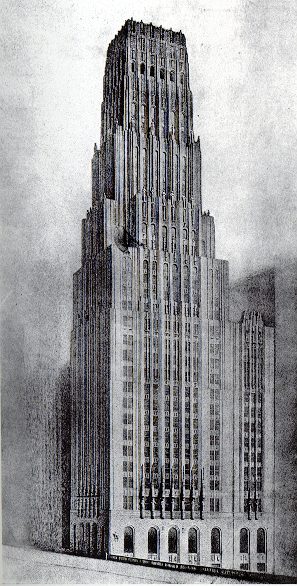
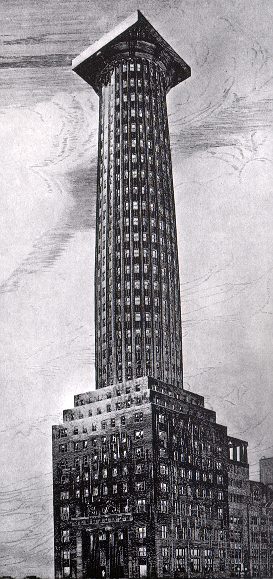
The entry on the left above was Eliel Saarinen's second prize proposal; the entry on the right was Adolf Loos' strange imitation of a classical column. While both were fascinating designs, the winning design had something that they did not: a plan to illuminate the building in a way that would rival the lighting scheme of Wrigley's tower. The winning design was conceived of by Raymond Hood and John Mead Howells. The top of their neo-gothic tower is still lit with color at night:
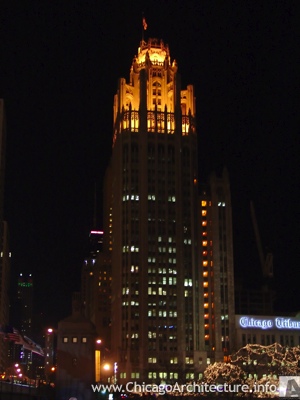
Neumann writes of architectural lighting designer Bassett Jones' proposed illumination of the Chicago Tribune Tower:
- From each of the fifth-floor windows, floodlights with reddish filters would cast their beams down towards the sidewalk...the shaft of the building would remain dark from this level to the twenty-sixth story, where strip lights would be installed in the windowsills. Opal glass lit from within would enclose the windows of the next floor. The stone tracery of the first roof level would be silhouetted against the illuminated central tower...here, again a rose-colored light would gradually fade as it reached upward. Finally, eight incandescent searchlights would serve as beacon at the top...steam would be discharged from the upper tower, illumined by fire-color lights, and supplemented by smoke and fireworks. (3)
This vertical progression of cinematic light playing on the neo-gothic facade would have been spectacular, if implemented. It would have served as a marvelous beacon - visible from all around the city - as well as involved people walking by it on the sidewalk. Unfortunately, the plan was reduced to just the lights in the 'crown' of the building, which still light it today. Though not as intense as the original proposal, the uplighting of the craggy crown of the building make it impressive and instantly recognizable.
A modern example of dynamic skyscraper illumination is the Burj al Arab Hotel in Dubai. Commissioned by the ruling Sheikh of Dubai in 1999, the skyscraper is the world's tallest hotel; it is also a seven-star hotel, connecting skyscrapers with wealth and ultimate luxury. An incredible lightshow takes place on the side of the hotel's teflon-coated fiberglass fabric exterior skin. Strobe lights, pulsing colored lights running up the facade, built-in image projectors and slow color transitions are all part of the nightly show. Because of the translucent exterior wall, the guests inside and city outside can see the lights (4). The lightshow is fantastical, suggesting the escape and luxury available within, as well as the 24-hour powerful presence of the tower within the urban context.
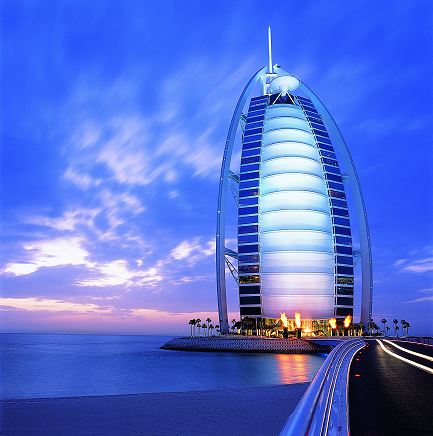
Skyscraper illumination allows buildings to reflect the passage of the day; when people are beginning to leave their work in skyscrapers, the skyscrapers are simultaneously beginning to light up. The illumination signifies a time of transition. Many cities also use their illuminated skyscrapers to denote seasons - notice the red and green lights currently topping at least two Providence skyscrapers. Illumination allows skyscraper to maintain an active presence - perhaps even to define the city - at night, as lit skyscrapers help people move around the city at night by providing points of reference and light to walk and drive by. Lit skyscrapers certainly draw more attention to their own cinematic and imaginative possibilities than non-lit skyscrapers; the use of skyscraper as dynamic urban theater, complete with special effects, is fascinating.
Footnotes:
1. Neumann, Dietrich and Kermit Swiler Champa. Architecture of the Night: The Illuminated Building. London: Prestel Publishing, 2003. 1.
2. Neumann, 108.
3. Neumann, 142.
4. Neumann, 220.
